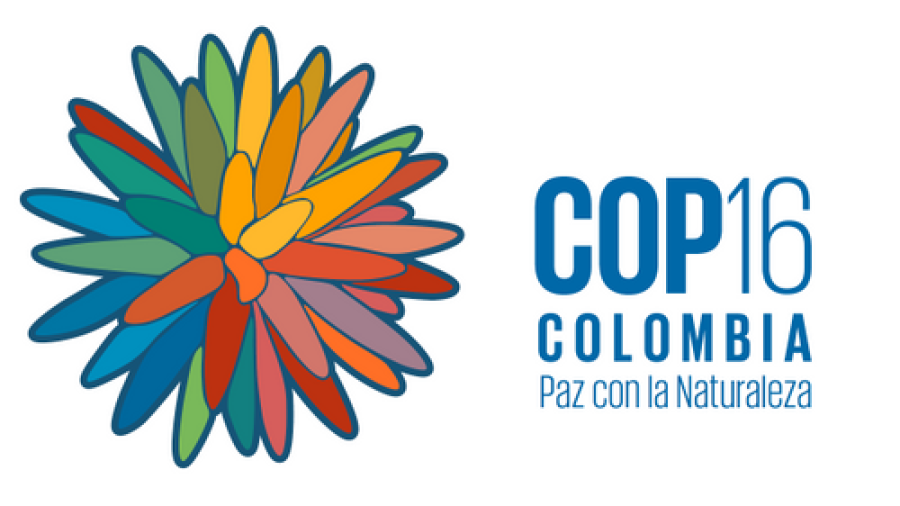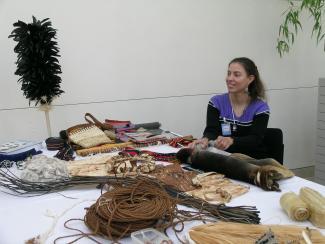
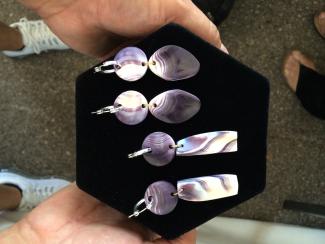
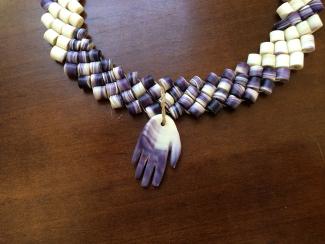
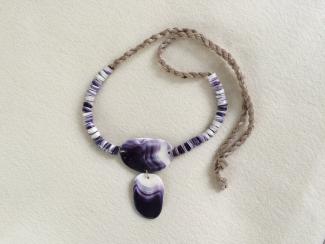
Elizabeth James-Perry (Aquinnah Wampanoag) is a traditional Native artist specializing in wampum jewelry, textile arts, and illustration from Martha’s Vineyard, Massachusetts. In 2014 she received a prestigious Traditional Arts Fellowship from the Massachusetts Cultural Council. Using the traditional depiction of North America as Turtle Island, she produced the drawings for the turtle mural installed in the Aquinnah Tribe’s educational kiosk.
“My family encouraged us to be creative, resourceful, and brought us up to be mindful of our Native heritage,” James-Perry says. “I have good childhood memories associated with the island and mainland Native scene of waiting for the ferry to get us out to our spring social on the Vineyard, how lively and crowded those gatherings always were...gatherings we used to hold with my brother’s drum group, and even of being brought as a youngster to tribal m eetings with my mother. My grandmother was a wonderful cook, and she and older aunts came to stay with us and shared family histories. Most weekends we spent enjoying the outdoors.”
James-Perry credits her cousins with teaching her the crafts of spinning, weaving, and beadwork as a teenager, after which she gradually made the transition into finger weaving wool and jewelry design with purple quahog and white oyster shell from local waters. Wampum is a challenging medium, so she found it “heartening to see how talented tribal folks on the island and Cape Cod successfully and consistently worked the shell in various forms, combining it with brass, sinew, and other materials.” She says she draws inspiration from the ghost images in shell, sometimes seeing a mysterious bear or whale emerge from the first cut oval or square.
Historically, wampum belts have been used in tribal storytelling and as alliance-making gifts. It is an important Native material that is part of ceremo- nial culture, and so, James-Perry says, wampum will always be relevant. “It acts as a reminder to consider our past and future here in our homelands by the sea. And it connects us with other tribal Nations throughout the northeast in the United States and Canada that still hold the material in high regard. Artists are tactile: we generally learn as much through our hands and other senses as we do visually. You can only do so much explaining or reading. Much is experiential, and can only be deeply understood with years of practice. At some point it’s crucial to be quiet and just experience the art.”
To James-Perry, there is a marked difference between machine and hand- made; artists put themselves into their art, and age-old techniques for crafting wampum ensure the time is worth the investment. These are heirloom pieces, meant to be handed down for generations. She explains that the wild-harvest- ing supplies necessary for weaving require hunting for plants in a time when private property rights make it challenging. And in New England, of course, there is also the matter of short gathering seasons to contend with.
Still, she says, “it is enjoyable to spend an autumn weekend picking rhubarb leaves, sunflower, and Jerusalem artichoke petals, or dry crunchy oak galls in the woods.”
One of James-Perry’s current projects is to twine-weave a colorful women’s yarn sash for the Native Fashion Now Exhibit at Peabody Essex Museum later this year. Along with the sash, a curved wampum beaded bias collar with a small hand effigy, referred to in early sources as a friendship collar, and softly colored purple wampum earrings, will also be part of the traveling exhibit.
See more of her work at www.elizabethjamesperry.com.
Check out our upcoming schedule of Cultural Survival Bazaars at www.bazaar.cs.org. July 18-19: Falmouth, MA; July 25-26: Tiverton, RI; August 1-2: Cambridge, MA; October 10-12: Amherst, MA
All photos courtesy of Elizabeth James-Perry
Image One: Elizabeth James-Perry during a textile residency at the Peabody Essex Museum
Image Two: Long earrings of the artist's design at the first Indigenous Fine Arts Market in Santa Fe, New Mexico.
Image Three: Timeless style: a traditional wampum friendship collar.


